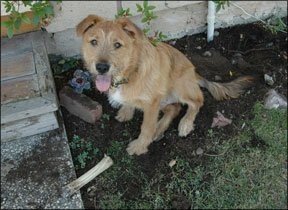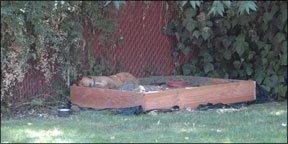How to Solve Digging
Management, not Training, Solves this Behaviour Problem.
Originally produced by Nancy Kerns
The perfect storm, canine edition: Combine one dog who is accustomed to and prefers spending time outdoors; a spate of hot, dry weather; a lush, productive garden full of herbs and tomato plants growing in raised boxes full of expensive, loamy soil and moistened three times daily by an automatic drip system. What do you get? Holes dug in the garden and an irate husband!
On his second day in his new home, Otto had already dug several holes to lie in, including this one under an azalea the author’s husband was fond of – oops! Giving him his very own cool place to dig and snooze solved all unwanted digging.

Our new dog, Otto, nearly made himself quite unwelcome on his second day in our home. Every time I turned around, I’d find him digging in any place we’d recently watered, including the lawn, a flowerbed in front of the house, underneath a gorgeous hydrangea bush that’s already hard-pressed to survive our hot summers, and, most seriously, the vegetable beds in back. “Can’t you train this dog not to dig?” my husband implored.
But this wasn’t a training issue; I’ve been trained enough by Pat Miller and our other contributing trainer/writers to recognize a management situation when I see it!
Training vs Management
Training is the right thing to do when you want to get a dog to do something specific: fetch a ball, sit when greeting people, walk calmly on leash. But when you would like a dog to not do something – especially when you’d like him to not do it in your absence – you need to manage the situation.
For example, if a dog gets into and eats stuff out of the kitchen garbage pail, you could try to “catch him in the act” and punish him for it, or set up booby traps that would accomplish the same thing. Unfortunately, dogs generally have more idle time on their hands than we do; these approaches take more time and surveillance skills than most of us possess. Traps and stakeouts are unlikely to be successful, anyway; with a random reinforcement of some tasty old food, most dogs are motivated to persist through whatever traps or punishment they occasionally are subjected to. It makes far more sense to manage the situation by putting the pail in a location where he can’t possibly get into it (under the sink, say, with a baby-proof latch on the cupboard door).
Fortunately, we had a perfect spot available for a digging box: a deeply shady and unused back corner of the yard, far from the raised garden beds. I was slightly worried that it was far enough from the house and my office that Otto would find it too isolated and would be disinclined to hang out there.
A Win/Win Situation
Management solutions are most successful if they both A) absolutely prevent the dog from being rewarded for doing the thing you don’t want him to do, and B) reward him for doing something else. Unless we keep Otto inside (which he really doesn’t enjoy, and seems to encourage him to chew on household items), build a kennel on a concrete slab, or cover our entire lot in concrete, we can’t prevent Otto from digging. Fortunately, we have room in our yard to try Plan B: to give him a rewarding experience doing what he wants to do, but in a location of our choice.
It was clear to me that Otto wasn’t just digging for the fun of digging; he wasn’t burying toys or looking for gophers. Rather, he was trying to find a cool, damp place to beat the hot, dry weather we have all summer long in this part of California. Once he got a hole dug, he’d circle and hunker down in the hole for a nap. I proposed that we provide Otto with an especially cool, damp, shady spot where he could dig and snooze to his heart’s delight.

Methods & Materials
Otto is a good-sized dog, about 50 pounds and fairly long. We wanted the box to be big enough for his digging and relaxing pleasure. After measuring his stretched-out length, we decided the ideal size would be 4 feet by 6 feet, and so we bought two 10-foot boards from which to make the frame. We also decided that 10 inches would be deep enough (he really didn’t dig very deep, just wide, when he dug), so we used boards that were 2 inches by 10 inches.
Digging It
The box was a smash hit with Otto before it was even completed. I had barely begun filling the box with sand when Otto got in, and he didn’t get out until hours later. Best of all, a month later, it’s still his favourite place to spend a hot day – and he’s dug another hole in the garden only once. He stays relatively clean (compared to when he was sleeping in damp soil), and though he has thrown a lot of sand out of the box, its out-of-the-way location means it’s fine by us.
Here’s where and how Otto spends most of every hot day now: snoozing in the sand. He brings toys to chew and bury, but mostly he digs trenches and then burrows down into them. Every few days, I spray the sand with water to keep it damp and cool, and rake the sand smooth, which sets Otto off into a new fit of exuberant excavating.
If he hadn’t taken to his sandbox so quickly, I was prepared to spend time with Otto in the box, give him treats and praise for hanging out there, and perhaps show him how to bury and dig for some of his favourite toys. None of these were necessary – but building sand castles, just for the fun of watching Otto happily dig them apart, has proven to be a blast.

